#Jacob van Loo
Text

Jacob van Loo (1614-1670)
"Group of Musicians" (c. 1650-1652)
Oil on canvas
Dutch Golden Age
Located in the Thyssen-Bornemisza Museum, Madrid, Spain
#paintings#art#artwork#genre painting#genre scene#jacob van loo#oil on canvas#fine art#dutch golden age#baroque#thyssen bornemisza museum#museum#art gallery#dutch artist#musician#musical instruments#clothing#clothes#1650s#mid 1600s#mid 17th century
93 notes
·
View notes
Text
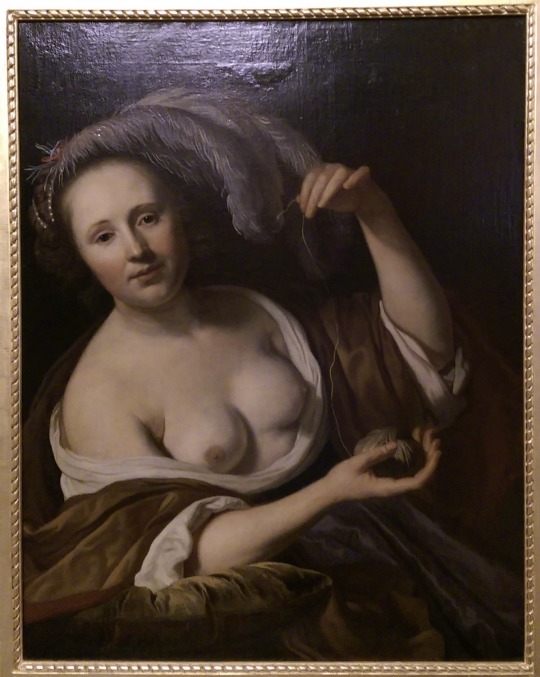
Jacob van Loo
8 notes
·
View notes
Photo

17th century Attributed to Jacob van Loo - Portrait of a child, full-length, in a white gown and bonnet
(Private collection via Christie’s)
132 notes
·
View notes
Text
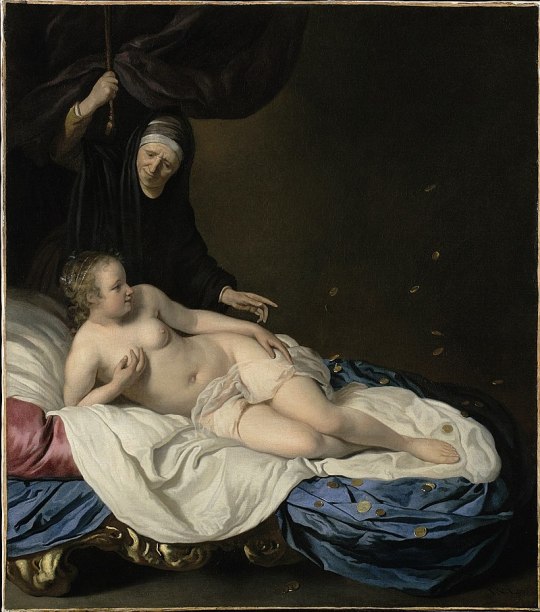
Jacob van Loo
Danaë, circa 1650
Oil on canvas
Museum of Fine Arts, Budapest
#art#art history#dutch baroque#painting#oil painting#jacob van loo#Danaë#museum of fine arts budapest
2 notes
·
View notes
Text
La joven se acuesta o "la hora de acostarse a la italiana" de Jacob Van Loos (MBA, Lyon)
La joven se acuesta o “la hora de acostarse a la italiana). MBA, Lyon.
Pintura bastante poco habitual en la Holanda protestante del Siglo XVII, presenta a una mujer joven que, desnuda, procede a mirar al espectador de forma coqueta, mientras se va a meter en la cama. No se sabe exactamente la fecha del cuadro, pero sí se sabe que es anterior a 1670.
Su autor, Jacob Van Loos, había nacido en las…

View On WordPress
#Amsterdam#Francia#Holanda#Jacob Jordaens#Jacob van Loos#Jean-Auguste-Dominique Ingres#Lyon#Martinus Lengele#Museo de Bellas Artes de Lyon#Museo del Louvre#París#Pintura#Siglo XIX#Siglo XVII
1 note
·
View note
Text
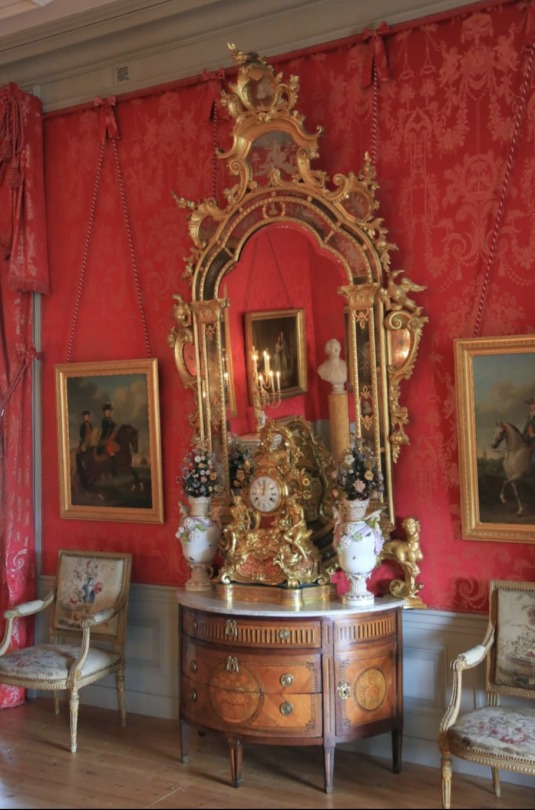
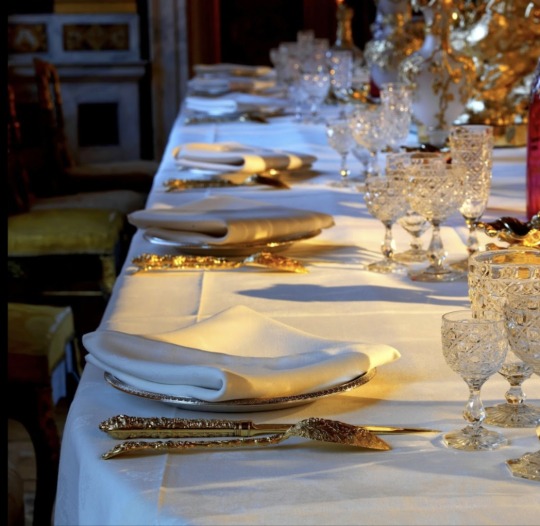


#Het Loo Palace es un palacio en Apeldoorn#Países Bajos. El edificio barroco holandés simétrico fue diseñado por Jacob Roman y Johan van Swi
1 note
·
View note
Text














taylor swift lyrics x colors x textiles in art – gold
Tied Together with a Smile – Taylor Swift // Portrait of Archduchess Maria Magdalena of Austria – Frans Pourbus the Younger 💛 The Best Day – Fearless // Amarillis Crowning Mirtillo – Jacob van Loo 💛 Castles Crumbling – Speak Now // Madame Sophie of France – Jean-Marc Nattier 💛 State of Grace – Red // Louise, Queen of the Belgians, as Marie de Bourgogne – Jean Baptiste Madou 💛 End Game – Reputation // Princess Louisa Maria Teresa Stuart – Alexis Simon Belle 💛 So It Goes… – Reputation // King Gustav III of Sweden and His Brothers – Alexander Roslin 💛 Dancing with Our Hands Tied – Reputation // Noble Lady – Moritz Stifter 💛 Dress – Reputation // Portrait of Jemima Crew, Countess of Kent – Workshop of Godfrey Kneller 💛 Daylight – Lover // Portrait of Frances Theresa Stuart, Duchess of Richmond and Lennox – Peter Lely 💛 invisible string – folklore // Princess Margareta – Oscar Björck 💛 invisible string – folklore // Portrait of Eleanor Maria Josepha of Austria – Benjamin Block 💛 gold rush – evermore // Portrait of Doge Francesco Venier – Titian 💛 coney island – evermore // Portrait of Princess Louise Marie of France – attributed to François-Hubert Drouais 💛 long story short – evermore // King Gustav III of Sweden – Alexander Roslin
#taylor swift debut#taylor swift self titled#fearless taylor swift#fearless taylor’s version#fearless#red taylor swift#red taylor’s version#red tv#red#reputation taylor swift#reputation album#reputation#lover taylor swift#lover#lover album#folklore album#folklore#folklore ts#folklore taylor swift#evermore ts#evermore taylor swift#evermore album#evermore#taylor swift#gold#art history#taylor swift lyrics x colors x textiles in art#long post
173 notes
·
View notes
Text
The Dionysos gallery (2)
Next on our travel down the Dionysos museum, we have an entire section dedicated to the Bacchanals in painting - with a few analysis here and there.
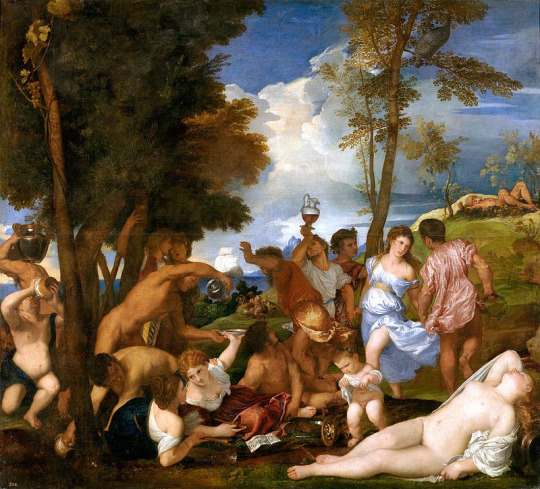
Titien's The Bacchanal of the Andrians
The Museum's website adds that this depicts the legend of how Dionysos gifted the inhabitants of the island of Andros with a river of wine. It was one of the numerous "miracles" attributed to the god by folk-belief when he became the god of the grapevine. Already in his "Bacchants" Euripides had told how, by touching a stone with his thyrsus he created a stream of fresh water, and where his narthex had touched the ground a stream of wine flowed ; and those that sought milk only had to scratch the ground near the god to see it flow, and from the god's thyrsus honey dropped...
In Ionia, on the island of Teos, a similar legend existed: it was said, by Diodor of Sicily and Pline the Elder, that at a fixed date in a calendar a stream of wine regularly flowed. At Elis, on the eve of the god's feast-day, empty jars and jugs were sealed and left alone in Dionysos' temple: by the morning, when they were opened, they were filled to the brim with wine.

Giovanni Bellini and Titien's The Feast of the Gods
The museum adds this mention: the painting is a depiction of the legend of Lotis collected by Ovid. One night, as the gods had a feast, the nymph Lotis fell asleep. Priapus got close to her, and with his famous ithyphallic nature, he decided to rape her. But as he was about to touch her body, the donkey of Silenus started making loud noises - waking up everybody, including Lotis. Lotis fled from Priapus' embrace, and all the gods laughed and mocked the god.
This painting was most notably the favorite painting of Fernand Botero.

Dosso Dossi's Bacchanal with a drunk Silenus and Bacchants frolicking around grapevine
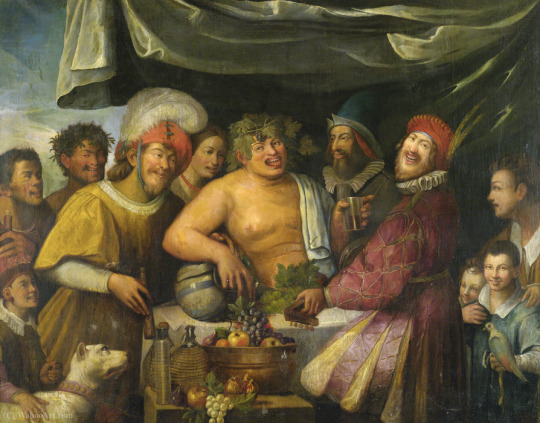
Niccolo Frangipane's Bacchanal

Nicolas Poussin's Bacchanal

Nicolas Poussin's Bacchanal with a guitar player ; also called "Great Bacchanal"
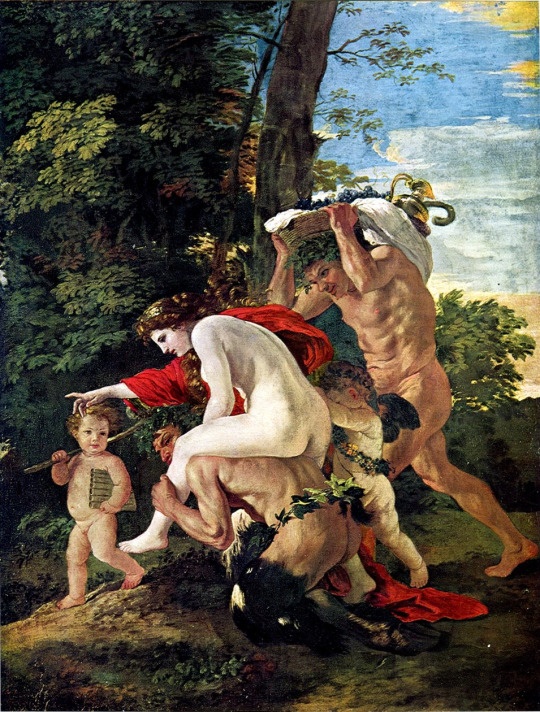
Nicolas Poussin's Bacchic Scene

Pier Francesco Mola's Bacchus supervising the Satyrs pressing wine

Gerrit van Bronckhorst's Bacchanal with Silenus
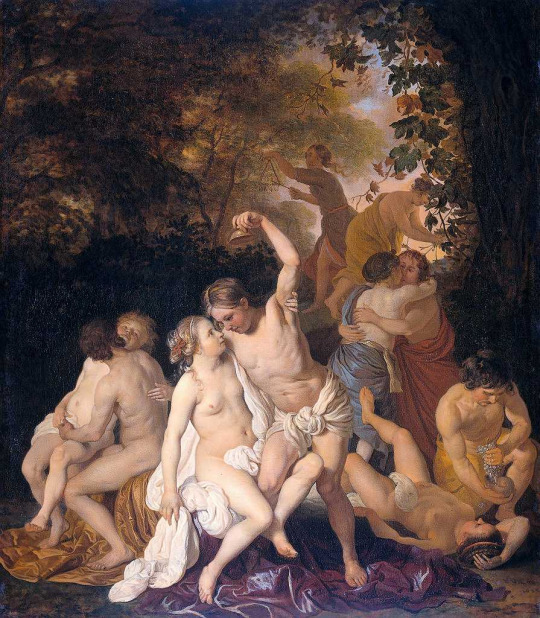
Jacob van Loo's Scene with Bacchants

Michaelina Wautier's Bacchanal
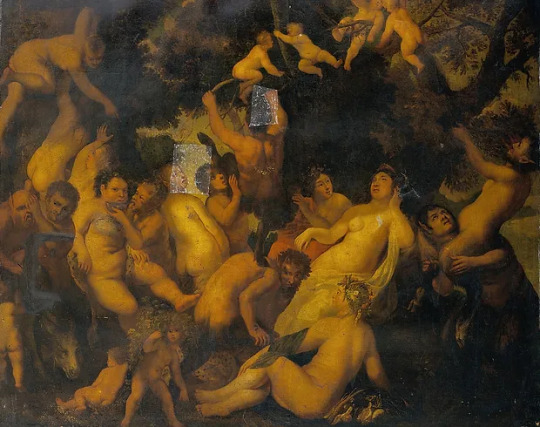
Jacques Jordaens' Bacchanal
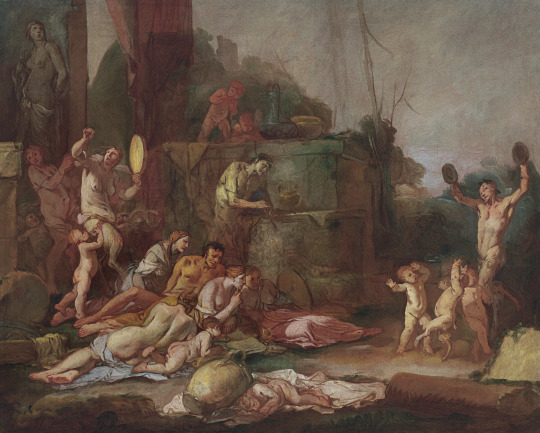
Giulio Carpioni's Bacchanal

Michel-Ange Houasse's Bacchanal
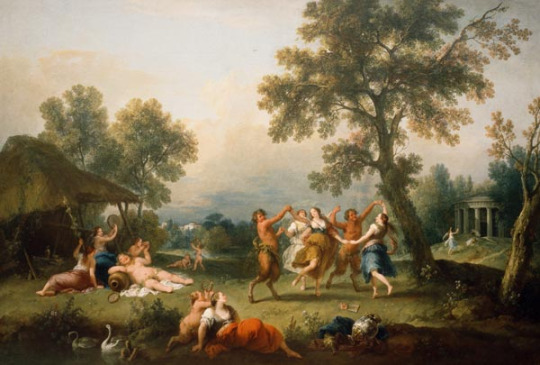
Francesco Zuccarelli's Bacchanal
#dionysos#the art of the myth#dionysus#bacchanal#the dionysos gallery#silenus#bacchants#greek mythology#painting#art
39 notes
·
View notes
Text

Jacob van Loo (1614-1670)
"A Bacchanal"
Oil on canvas
Dutch Golden Age
Currently in a private collection
#paintings#art#artwork#ancient rome#bacchus#jacob van loo#oil on canvas#fine art#dutch golden age#baroque#private collection#dutch artist#bacchanal#bacchante#male nude#male portrait#male figure#portrait of a man#female nude#female portrait#female figure#portrait of a woman#1600s#17th century
87 notes
·
View notes
Text

Lars Elling
Studie etter Jacob Van Loo
#lars elling#art#painting#oil painting#oil on canvas#contemporary painting#contemporary art#figurative art#figurative painting
42 notes
·
View notes
Photo










Fleabag 2x06 / The Perks of Being a Wallflower by Steven Chbosky / Skins 3x08 / A Midsummer Night’s Dream by William Shakespeare / Stranger Things 4x03 / Fleabag 2x04 / I Love You Without Knowing How by Pablo Neruda / Amarillis crowning Mirtillo (1650) by Jacob van Loo / Hannibal 2x13 / Hannibal 3x13
#web weaving#love#heartbreak#unrequired love#fleabag#the perks of being a wallpaper#skins#effy stonem#james cook#william shakespeare#a midsummer night's dream#pablo neruda#i love you without knowing how#jacob van loon#hannibal#will graham#hannibal lecter#stranger things#eleven#mike wheeler
132 notes
·
View notes
Text
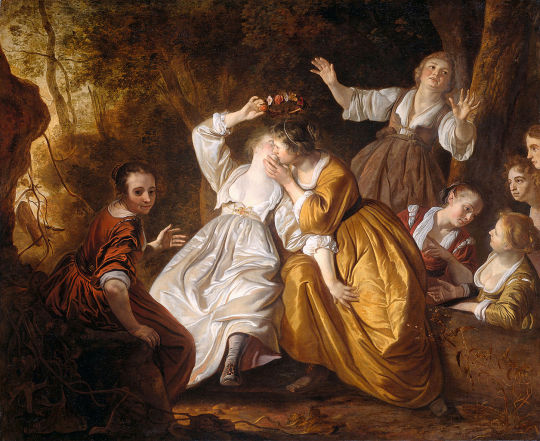
Jacob van Loo, Amarillis crowning Mirtillo (1650)
#amarillis crowning mirtillo#jacob van loon#wlw art#historical art#historical painting#history#herstory#1600s#1600s art#wlw#wlw romance#sapphic#women
15 notes
·
View notes
Photo

Portrait of a Woman by Jacob van Loo, mid 1600s, Holland.
19 notes
·
View notes
Text
Portrait of Princess Louise Hippolyte of Monaco (1687-1731) by Jean Baptiste van Loo

About Louise Hippolyte of Monaco: Louise Hippolyte (10 November 1697 – 29 December 1731) was one of only two women to rule Monaco, reigning as Princess of Monaco from 20 February 1731 until her death in December the same year. She was the second daughter of Antonio I of Monaco and Marie de Lorraine-Armagnac. The second of six children born to her parents, she was the first of their children to survive infancy. She had sisters, but no brothers. Her father decided, with the permission of Louis XIV, that her future husband should assume the surname of Grimaldi and rule Monaco jointly with her. On 20 October 1715, at the age of eighteen, she married Jacques François Goyon, Count de Matignon. His candidacy was supported by King Louis XIV, who wanted to consolidate French influence in Monaco. Prior to this, Louise Hippolyte's father was eager to wed his daughter to a Grimaldi cousin. This marriage did not materialise due to the poor finances of the Grimaldis at the time. The marriage was not happy. Louise Hippolyte was described as a shy, while Jacques openly flaunted his mistresses in the royal court at Versailles. They had nine children together. Her father died on 20 February 1731. Louise Hippolyte traveled without her family from Paris to Monaco. As was customary in the case of female monarchs, it had originally been the plan to proclaim Jacques as her joint co-regent. However, it became clear that the people of Monaco did not welcome a Frenchman as co-ruler of Monaco and would prefer Louise Hippolyte as their sole ruler. Louise took advantage of this and took the oath as ruler of Monaco herself before Jacques had arrived. Finding himself without power, he soon returned to France.Princess Louise-Hippolyte ruled Monaco for seven months. She is described as a popular ruler during her short reign. She died of smallpox at the end of 1731.Following her death, her husband took power in Monaco, her son being a minor. Jacques neglected the affairs of Monaco and had to leave the country in May 1732. His ambition was to be declared regent until his son reached the age of 25, after which his son should abdicate his throne to him, but this was not accepted in Monaco. He abdicated in favor of their son, Honoré, the next year.
About the artist and his family: Jean-Baptiste van Loo (14 January 1684 – 19 December 1745) was a French subject and portrait painter.He was born in Aix-en-Provence, and was instructed in art by his father Louis-Abraham van Loo, son of Jacob van Loo (a painter of the Dutch Golden Age, known particularly for his mythological and biblical scenes. He was especially celebrated for the quality of his nudes to the extent that, during his lifetime, particularly his female figures were said to have been considered superior and more popular than those of contemporary and competitor Rembrandt.Though his father also painted, Jacob's success ensured that he would forever be referred to as the founder of the Van Loo family of painters; a dynasty which was influential in French and European painting from the 17th to the beginning of the 19th century.) Jean-Baptiste van Loo was patronized by the prince of Carignan, who sent him to Rome, where he studied under Benedetto Luti. In Rome he was much employed painting for churches.At Turin he painted Charles Emmanuel II, Duke of Savoy and several members of his court. Then, moving to Paris, where he was elected a member of the Académie Royale de Peinture et de Sculpture, he executed various altar-pieces and restored the works of Francesco Primaticcio at Fontainebleau. He also painted portraits of aristocrats living in or visiting Paris. In 1737 he went to England. He also painted Sir Robert Walpole, whose portrait by van Loo in his robes as chancellor of the exchequer is in the National Portrait Gallery, London, and the prince and princess of Wales. He did not, however, practise long in England, because of his failing health; he retired to Paris in 1742, and afterwards to Aix-en-Provence, where he died on 19 December 1745. His likenesses were striking and faithful, but seldom flattering. (I might post more about his work and his family's)
#new post#historical fashion#costume drama#dress#period piece#new to tumblr#pretty#princess#portrait#painting#politics#royalty#royals#monaco#house of grimaldi#monte carlo#oil on canvas#oil painting#fun facts#historical drama#historical#fashion history#history#long post#arranged marriage#louis xiv#palace of versailles#versailles#art#artist
15 notes
·
View notes
